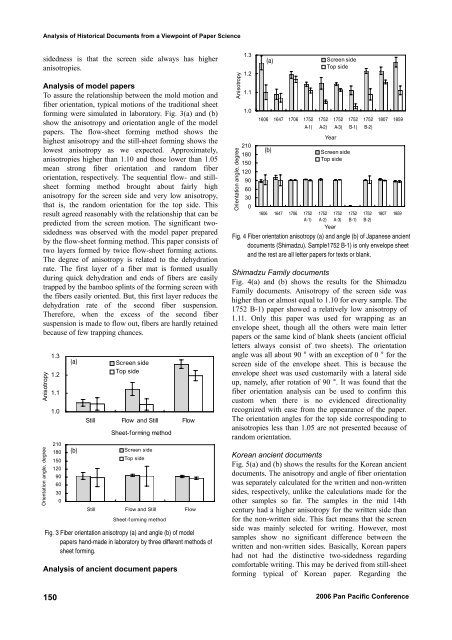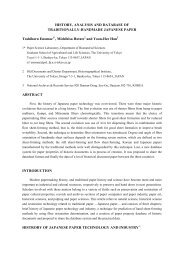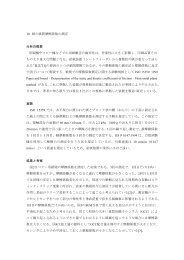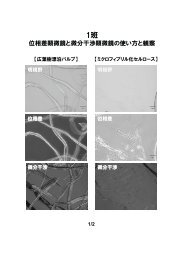Analysis of Historical Documents from a Viewpoint of Paper Science
Analysis of Historical Documents from a Viewpoint of Paper Science
Analysis of Historical Documents from a Viewpoint of Paper Science
Create successful ePaper yourself
Turn your PDF publications into a flip-book with our unique Google optimized e-Paper software.
<strong>Analysis</strong> <strong>of</strong> <strong>Historical</strong> <strong>Documents</strong> <strong>from</strong> a <strong>Viewpoint</strong> <strong>of</strong> <strong>Paper</strong> <strong>Science</strong><br />
sidedness is that the screen side always has higher<br />
anisotropies.<br />
<strong>Analysis</strong> <strong>of</strong> model papers<br />
To assure the relationship between the mold motion and<br />
fiber orientation, typical motions <strong>of</strong> the traditional sheet<br />
forming were simulated in laboratory. Fig. 3(a) and (b)<br />
show the anisotropy and orientation angle <strong>of</strong> the model<br />
papers. The flow-sheet forming method shows the<br />
highest anisotropy and the still-sheet forming shows the<br />
lowest anisotropy as we expected. Approximately,<br />
anisotropies higher than 1.10 and those lower than 1.05<br />
mean strong fiber orientation and random fiber<br />
orientation, respectively. The sequential flow- and stillsheet<br />
forming method brought about fairly high<br />
anisotropy for the screen side and very low anisotropy,<br />
that is, the random orientation for the top side. This<br />
result agreed reasonably with the relationship that can be<br />
predicted <strong>from</strong> the screen motion. The significant twosidedness<br />
was observed with the model paper prepared<br />
by the flow-sheet forming method. This paper consists <strong>of</strong><br />
two layers formed by twice flow-sheet forming actions.<br />
The degree <strong>of</strong> anisotropy is related to the dehydration<br />
rate. The first layer <strong>of</strong> a fiber mat is formed usually<br />
during quick dehydration and ends <strong>of</strong> fibers are easily<br />
trapped by the bamboo splints <strong>of</strong> the forming screen with<br />
the fibers easily oriented. But, this first layer reduces the<br />
dehydration rate <strong>of</strong> the second fiber suspension.<br />
Therefore, when the excess <strong>of</strong> the second fiber<br />
suspension is made to flow out, fibers are hardly retained<br />
because <strong>of</strong> few trapping chances.<br />
Anisotropy<br />
degree<br />
Orientation angle,<br />
1.3<br />
1.2<br />
1.1<br />
1.0<br />
210<br />
180<br />
150<br />
120<br />
90<br />
60<br />
30<br />
0<br />
(a)<br />
(b)<br />
Screen side<br />
Top side<br />
Still Flow and Still Flow<br />
Sheet-forming method<br />
Screen side<br />
Top side<br />
Still Flow and Still Flow<br />
Sheet-f orming method<br />
Fig. 3 Fiber orientation anisotropy (a) and angle (b) <strong>of</strong> model<br />
papers hand-made in laboratory by three different methods <strong>of</strong><br />
sheet forming.<br />
<strong>Analysis</strong> <strong>of</strong> ancient document papers<br />
Anisotropy<br />
Orientation angle, degree<br />
1.3<br />
1.2<br />
1.1<br />
1.0<br />
210<br />
180<br />
150<br />
120<br />
90<br />
60<br />
30<br />
0<br />
(a)<br />
1606 1647 1706 1752<br />
A-1)<br />
(b)<br />
1606 1647 1706 1752<br />
A-1)<br />
1752<br />
A-2)<br />
Screen side<br />
Top side<br />
1752<br />
A-2)<br />
Screen side<br />
Top side<br />
Year<br />
Year<br />
1752<br />
A-3)<br />
1752<br />
A-3)<br />
1752<br />
B-1)<br />
1752<br />
B-1)<br />
1752<br />
B-2)<br />
1752<br />
B-2)<br />
1807 1859<br />
1807 1859<br />
Fig. 4 Fiber orientation anisotropy (a) and angle (b) <strong>of</strong> Japanese ancient<br />
documents (Shimadzu). Sample1752 B-1) is only envelope sheet<br />
and the rest are all letter papers for texts or blank.<br />
Shimadzu Family documents<br />
Fig. 4(a) and (b) shows the results for the Shimadzu<br />
Family documents. Anisotropy <strong>of</strong> the screen side was<br />
higher than or almost equal to 1.10 for every sample. The<br />
1752 B-1) paper showed a relatively low anisotropy <strong>of</strong><br />
1.11. Only this paper was used for wrapping as an<br />
envelope sheet, though all the others were main letter<br />
papers or the same kind <strong>of</strong> blank sheets (ancient <strong>of</strong>ficial<br />
letters always consist <strong>of</strong> two sheets). The orientation<br />
angle was all about 90 ° with an exception <strong>of</strong> 0 ° for the<br />
screen side <strong>of</strong> the envelope sheet. This is because the<br />
envelope sheet was used customarily with a lateral side<br />
up, namely, after rotation <strong>of</strong> 90 °. It was found that the<br />
fiber orientation analysis can be used to confirm this<br />
custom when there is no evidenced directionality<br />
recognized with ease <strong>from</strong> the appearance <strong>of</strong> the paper.<br />
The orientation angles for the top side corresponding to<br />
anisotropies less than 1.05 are not presented because <strong>of</strong><br />
random orientation.<br />
Korean ancient documents<br />
Fig. 5(a) and (b) shows the results for the Korean ancient<br />
documents. The anisotropy and angle <strong>of</strong> fiber orientation<br />
was separately calculated for the written and non-written<br />
sides, respectively, unlike the calculations made for the<br />
other samples so far. The samples in the mid 14th<br />
century had a higher anisotropy for the written side than<br />
for the non-written side. This fact means that the screen<br />
side was mainly selected for writing. However, most<br />
samples show no significant difference between the<br />
written and non-written sides. Basically, Korean papers<br />
had not had the distinctive two-sidedness regarding<br />
comfortable writing. This may be derived <strong>from</strong> still-sheet<br />
forming typical <strong>of</strong> Korean paper. Regarding the<br />
150<br />
2006 Pan Pacific Conference

















